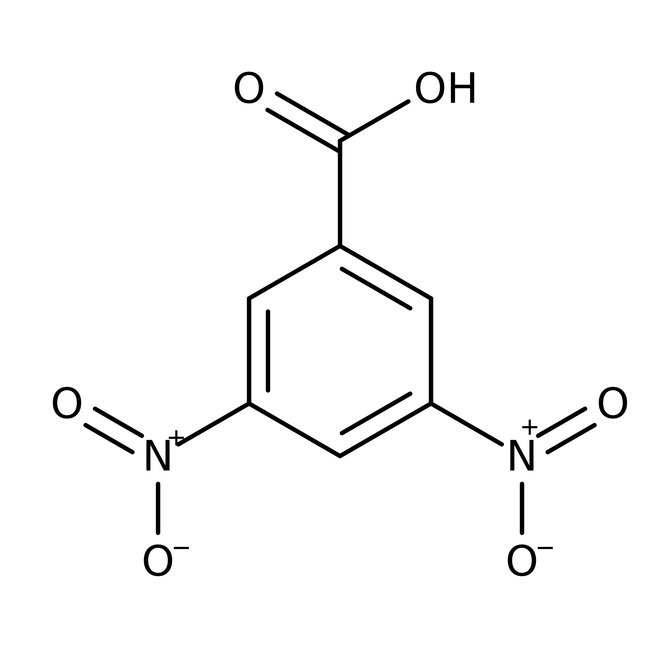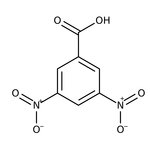Search Thermo Fisher Scientific
Thermo Scientific Chemicals
3,5-Dinitrobenzoic acid, 98+%
CAS: 99-34-3 | C7H4N2O6 | 212.12 g/mol
| Catalog Number | Quantity |
|---|---|
| ALFA16502.30 | 250 g |
Catalog number ALFA16502.30
View Price:Sign InSign in to see your account pricing. Need an account? Register with us today.
Quantity:
250 g
Specifications
Chemical Name or Material3,5-Dinitrobenzoic acid
CAS99-34-3
Health Hazard 1H302-H315-H319-H335
Health Hazard 2GHS H Statement
H301-H228-H315-H319-H335
Toxic if swallowed.
Flammable solid.
Causes skin irritation.
Causes serious eye irritation.
May cause respiratory irritation.
H301-H228-H315-H319-H335
Toxic if swallowed.
Flammable solid.
Causes skin irritation.
Causes serious eye irritation.
May cause respiratory irritation.
Health Hazard 3P261-P264b-P270-P271-P280-P301+P312-P302+P352-P304+P340-P305+P351+P338-P312-P330-P332+P313-P362-P501c
View more
3,5-Dinitrobenzoic acid, is used as a reagent used in the derivatization of resins and the determination of ampicillin.
This Thermo Scientific Chemicals brand product was originally part of the Alfa Aesar product portfolio. Some documentation and label information may refer to the legacy brand. The original Alfa Aesar product / item code or SKU reference has not changed as a part of the brand transition to Thermo Scientific Chemicals.
Applications
3,5-Dinitrobenzoic acid, is used as a reagent used in the derivatization of resins and the determination of ampicillin.
Solubility
It is Soluble in ethanol (50 mg/mL), methanol, alcohol (very), and glacial acetic acid (very). Insoluble in water.
Notes
Store in cool place. Keep container tightly closed in a dry and well-ventilated place. Keep away from Strong oxidizing agents, Strong bases, Strong reducing agents.
3,5-Dinitrobenzoic acid, is used as a reagent used in the derivatization of resins and the determination of ampicillin.
Solubility
It is Soluble in ethanol (50 mg/mL), methanol, alcohol (very), and glacial acetic acid (very). Insoluble in water.
Notes
Store in cool place. Keep container tightly closed in a dry and well-ventilated place. Keep away from Strong oxidizing agents, Strong bases, Strong reducing agents.
RUO – Research Use Only
General References:
- VR Pedireddi.; S Varughese. Solvent-dependent coordination polymers: Cobalt complexes of 3, 5-dinitrobenzoic acid and3, 5-dinitro-4-methylbenzoic acid with 4, 4'-bipyrdine. Inorg. Chem. 2004, 43, (2), 450-457.
- JL Lopez.; FSG Einschlag.; MC González. Hydroxyl radical initiated photodegradation of 4-chloro-3, 5-dinitrobenzoic acid in aqueous solution. Journal of Photochemistry and Photobiology . 2000, 137, (2-3), 177-184.



